The Museum Collections
Introduction
I. History and Art Collection
1. Icons of the 14th – 19th centuries
icons of the 14th – 17th century
2. Jewelry art of the 14th – 20th century
jewelry art of the 14th – 17th century
jewelry art of the 18th – 19th century
the european silver 14th - 19th centuries
3. Small-size sculptures (works of metal, wood, bone)
XI – the beginning of the XX century
Small-size sculptures 11th – 17th century
Small-size sculptures 18th – early 20th century
enamel of Troitza masters 15-8th – early 20th century
5.Embroidery, lace, textiles of the 14th - early 20th century
gold and silver lace
6.Painting of the 18th – 21st centuries
painting of the 18th – 19th centuris
painting of the 20th – 21st centuris
II.Manuscripts and old printed books of the 14th – 17th century
IV.Lithography of the 18th – 19th century
V.Numismatics
VI.Medals of the 18th - early 20th century
VIII.Archeology collection
IX. Russian folk and applied and decorative art of the 17th – 21st c.
1. Artistic wood
folk carved and painted wood
wooden toys
house carving of Sergiev Posad
Khokhloma and Gorodets painting
2. Artistic textiles
embroidery and weaving
printed textiles and lace
Russian shawls
folk costumes
folk garments
printed cotton kerchiefs
|
Small-Size Works of the 18th – Early 19th Centuries (Page 1) |
The church small-size works of the 18th – early 20th century is an integral extension of the medieval collection. But in contrast to the ancient part, this group was not historically accumulated, it is the result of the Museum collecting activity. At the New time relief images were more than once forbidden by the Holy Synod. In April 12, 1722, Peter I signed the order, requiring “not to store any carved and cast icons in churches, except small crosses and panagias”. In November 1832, Emperor Nikolai I signed a new decree forbidding sculptures in churches. Wooden altar crosses with carved images symbolizing the Crucifixion did not contradict the orders. Such cross was mounted in the Trinity Cathedral of the Trinity-St. Sergius Lavra in 1836. The complicated program and technique level could refer this cross to the best specimens of the 19th century small-size works.
In the 18th – early 20th centuries miniatures of bone, mother-of-pearl and different specious of wood and stone were mainly eulogia, mementos brought by Christians from holy places. They were mass-produced for pilgrims of different means. Usually they were of neither material no artistic value. Those mementos of long pilgrimage were kept in the icon-cases and passes from generation to generation. Some of them had inscriptions like “ Blessing from the Holy Sepulcher for devotional and good memory…”
T he collection of the Sergiev Posad Museum-Preserve includes carved icons and crosses, “representing” a lot of Orthodox centers: Palestine, Athos, the Kiev Lavra of the Caves and the Trinity-St. Sergius Lavra, the Solovetsky Monastery, St. Nil Hermitage. The major Palestine centers of pilgrimage and souvenir production are Jerusalem and Bethlehem. From these cities are numerous fine mother-of-pearl icons and crosses in the Museum collection. The group of icons depicting Adoration of the Shepherds, adoration of the Magi and the Nativity of Christ are connected with Bethlehem. The Jerusalem variant of the subject is levitating Christ with the Ascension Cathedral in the background, that is a combination of the event and the monument glorifying it. The icon with the image of St. John the Baptist, also brought from the Holy Land, is quite primitively carved in the wood cross section.
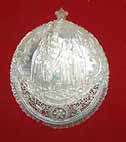
1. Icon carved in mother-of-pearl shell. Adoration of the Magi. Palestine. 19th century.
|
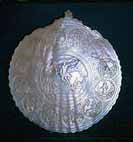
2. Icon carved in mother-of-pearl shell. The Resurrection of Christ. Feasts.
Palestine. 1867.
|
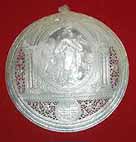
3. Icon carved in mother-of-pearl shell. The Baptism. Palestine. 19th century. |
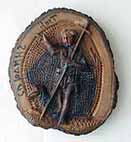
4. Olive cross section with the image of St. John the Baptist. Jerusalem. 19th century
|
The most interesting samples in the collection are the panagia with the carved coral images of Savior in a crown of thorns and the praying Virgin, pectoral cross and panagia made of mother-of-pearl for church services of Moscow Metropolitan Filaret (Drozdov) in the Assumption Gethsemane priory, wooden church service cross with lace-like carving of the 18th century which used to belong to Moscow Metropolitan Platon (Levshin).
The Athos works with intricate miniature carving depicting holy images were highly appreciated all over the Orthodox world. The Museum collection includes several panagias and crosses with inscriptions in Greek. One of the double-sided icons was probably presented to Moscow Metropolitan Filaret (Drozdov).
|
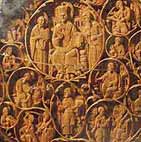
Panagia. Interceding saints before Christ Selected Saints and feasts. Athos. Early 20th c. |

Pectoral cross. Athos. 17th – 18th centuries |
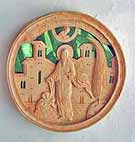
Double-sided icon. St. Filaret the Merciful. Athos. 1860s |
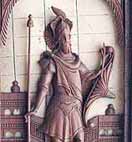
Miniature icon. St. Feodor Tyrone the Great Martyr. Kiev. 19th c.
|
«I“f you cannot afford to visit Jerusalem, welcome to the Russian Holy Town!” – wrote A.N. Muravjev from Kiev to Bishop Leonid (Krasnopevky) of Dmitrov in 1869.
Numerous and diverse eulogia from the Kiev Lavra of the Caves “introduced” a wide range of saints and relics of Kiev. Crosses and icons of different size depict the Lavra founders – SS. Antony and Feodosy of the Caves, St. Barbara, Archangel Michael and worshipped icons – the Virgin of the Caves and the Assumption.
|
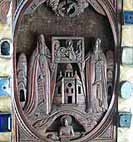
Miniature icon. SS. Antony and Feodosy of the Caves. Kiev. 19th century |
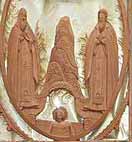
Miniature icon. SS. Antony and Feodosy of the Caves. Kiev. 19th century |
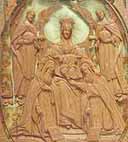
Miniature icon. The Virgin of the Caves. Kiev. 19th century
|
|
|


